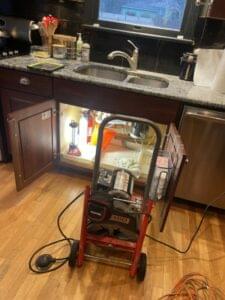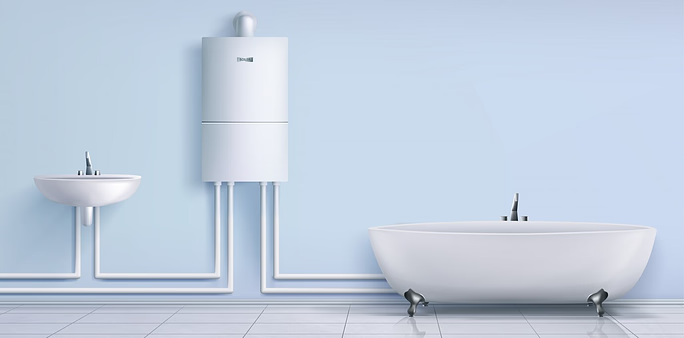Hot water is essential for our daily activities, whether it’s taking a shower or washing dishes. When we don’t have hot water, it can really throw off our routines and be a major inconvenience. That’s why it’s important to know the common reasons behind why we might not have hot water, so we can fix the problem quickly and effectively.
There are several reasons why you might not have hot water:
- Incorrect thermostat settings
- Inadequate water heater size
- Problems with mixing valves
- Gas water heater issues such as pilot light malfunctions
- Electric water heater problems like tripped breakers or faulty elements
- Sediment buildup within the tank
- Aging water heaters requiring frequent maintenance or replacement
In this article, we’ll explore these common issues in detail and offer practical solutions. By understanding the underlying cause of your hot water problem, you’ll be able to take the necessary steps to restore it and minimize any disruption to your daily life.
1. Thermostat Setting Issues
Understanding the Role of the Thermostat in Water Heaters
The thermostat in your water heater plays a crucial role in temperature regulation. It controls the heating elements or gas burner to maintain the water temperature at a set level, ensuring you have hot water when needed.
Recommended Temperature Settings for Water Heaters
For optimal performance and safety, manufacturers typically recommend setting the thermostat between 120°F and 140°F. The EPA suggests maintaining a minimum of 120°F to minimize the risk of scalding and reduce the likelihood of Legionella bacteria growth.
How to Check and Adjust Your Water Heater’s Thermostat
To verify and adjust your thermostat settings:
- Locate the Thermostat: This is usually found on the side of the water heater tank.
- Remove Access Panels: For electric heaters, remove the access panels to expose the thermostat.
- Use a Thermometer: Measure the current water temperature with an accurate thermometer.
- Adjust Settings: Turn the dial to your desired temperature within the recommended range.
- Replace Panels: Securely reattach any panels or covers removed during inspection.
Regularly checking and adjusting your thermostat can ensure consistent hot water availability.
2. Inadequate Water Heater Size
Matching your water heater size to your household needs is crucial for ensuring a consistent supply of hot water. An undersized water heater may run out of hot water during peak usage times, leaving you with unexpected cold showers.
Typical Sizes for Different Family Sizes
- 1-2 people: A 30-gallon tank usually suffices.
- 2-4 people: Opt for a 40-gallon tank.
- 4-6 people: A 50-gallon tank is recommended.
- 6+ people: Consider a tank of 80 gallons or more.
Signs That Your Water Heater Is Too Small
- Frequently running out of hot water
- Long recovery times between hot water availability
- Inconsistent water temperatures during usage
Ensuring your water heater has the right capacity can improve its efficiency and meet your household’s demands effectively.
3. Problems with Mixing Valves
Mixing valves play a crucial role in regulating the distribution of hot and cold water, ensuring a consistent temperature and preventing scalding. These valves blend hot and cold water to deliver the desired temperature to your faucets and showers.
Common issues with mixing valves can lead to insufficient hot water. Malfunctions may stem from:
- Improper settings: The valve might be set too low, affecting the hot water flow.
- Debris or mineral deposits: Blockages can hinder proper mixing.
- Wear and tear: Over time, components may degrade, causing malfunctions.
To check and adjust a mixing valve:
- Locate the valve: Typically found near your water heater.
- Inspect for debris: Clean out any visible blockages.
- Adjust settings: Use a screwdriver to turn the adjustment screw, usually marked with temperature indicators.
Regular maintenance of your mixing valve helps ensure optimal performance and consistent hot water delivery.
4. Gas Water Heater Troubles
Gas water heater problems often begin with understanding the pilot light. The pilot light ignites the gas burner, which then heats the water. If this small flame goes out, the heater will not work.
Checking the Pilot Light
- Locate the Pilot Light: Usually found at the base of the heater.
- Inspect for Flame: If it’s not lit, this is your problem.
- Relight Pilot: Follow manufacturer guidelines to safely relight it.
Understanding the Role of the Gas Control Valve
The gas control valve regulates gas flow to both the burner and pilot light. Any malfunction here can disrupt hot water supply.
Signs of a Failing Gas Control Valve
- Inconsistent water temperature
- No hot water even though pilot light is on
- Unusual noises or odors
Ensuring Open and Undamaged Gas Supply Line
A kinked or blocked gas supply line can also cause issues.
Steps to Inspect Your Gas Supply Line
- Visual Check: Look for obvious kinks or damage.
- Test Flow: Ensure gas is flowing freely by checking connections.
Both these checks can help identify and resolve many common gas water heater problems, ensuring a reliable hot water supply.
5. Electric Water Heater Problems
Understanding Circuit Breakers in Electric Heaters
Electric water heaters use circuit breakers to control the flow of electricity. When the breaker trips, it cuts off power to prevent electrical overloads or short circuits.
Steps to Check for a Tripped Breaker and Reset It
- Locate Your Electrical Panel: Usually found in basements, garages, or utility rooms.
- Identify the Water Heater Breaker: Look for a switch labeled ‘Water Heater’ or similar.
- Check the Position: If the switch is in the ‘Off’ position or halfway between ‘On’ and ‘Off’, it has likely tripped.
- Reset the Breaker: Flip it fully to ‘Off’ before turning it back to ‘On’.
The Importance of the Thermal Cutoff Switch
The thermal cutoff switch is an important safety feature in electric water heaters. Its main purpose is to shut off power if temperatures exceed safe limits, preventing overheating.
How to Reset the Thermal Cutoff Switch
- Turn Off Power: Switch off the corresponding breaker in your electrical panel.
- Access the Switch: Usually located behind an access panel on the water heater itself.
- Press the Reset Button: Typically red, press until you hear a click.
- Restore Power: Turn the breaker back on.
Signs of Thermostat or Heating Element Issues
- Inconsistent or No Hot Water: Could point to malfunctioning thermostats or heating elements.
- Unusual Noises: Popping sounds may indicate element issues due to sediment buildup.
- Higher Energy Bills: Reduced efficiency often signals failing components.
Testing and Replacing Thermostats and Heating Elements
- Turn Off Power: Again, ensure safety by switching off the breaker.
- Access Internal Components: Remove access panels using a screwdriver.
- Test Thermostats and Elements:
- Use a multimeter to check for continuity.
- Faulty components will show no continuity.
- Replace Faulty Parts:
- For thermostats, disconnect wiring and replace with new units.
- For heating elements, drain the tank partially, unscrew old elements with a wrench, and install new ones.
By addressing these common electric water heater issues, you can save time and money while ensuring a steady supply of hot water in your home.
6. Sediment Buildup in Water Heaters
Sediment buildup in water heaters is a common issue that can significantly impact the efficiency and lifespan of your unit. Over time, minerals like calcium and magnesium, found naturally in water, settle at the bottom of the tank. This sediment accumulation acts as an insulating layer between the burner and the water, reducing heating efficiency.
Causes and Effects
Causes:
- Hard water with high mineral content.
- Lack of regular maintenance and flushing.
Effects:
- Reduced heating efficiency leading to higher energy bills.
- Potential damage to the tank, including leaks or rupture due to overheating.
- Noisy operation due to sediment causing popping or rumbling sounds.
Methods for Flushing Sediment
- Turn Off the Heater: For gas heaters, set the thermostat to “pilot.” For electric models, switch off the power at the circuit breaker.
- Connect a Hose: Attach a garden hose to the drain valve located at the bottom of the tank.
- Drain the Tank: Open the drain valve and let the water flow out until it runs clear. Be cautious as this water may be hot.
- Flush with Cold Water: Close the drain valve, remove the hose, and refill the tank partially with cold water. Repeat draining until sediment is gone.
- Refill and Restart: Once clear, close all valves, remove hoses, refill your tank completely, and turn on your heater.
Regularly flushing your hot water heater can prevent costly repairs and maintain its efficiency. Ensuring that these steps are part of your routine maintenance can save you from unexpected cold showers.
7. Aging Water Heaters and Maintenance Needs
Aging water heaters can show signs that suggest replacement instead of repair. It’s important to notice these signs to maintain a reliable hot water supply:
- Frequent Repairs: If your unit needs constant fixes, it may be cheaper to invest in a new heater.
- Rusty Water: Discolored water could mean internal rusting, indicating that the water heater is nearing the end of its life.
- Noisy Operation: Loud sounds like popping or rumbling often come from sediment buildup, which can damage the tank over time.
- Inconsistent Heating: Difficulty keeping a consistent water temperature might be due to an aging unit.
Regular maintenance checks are crucial for extending the life of your water heater. Here are some key practices:
- Flush the Tank Annually: This removes sediment buildup, improving efficiency and preventing damage.
- Inspect Anode Rods: These rods attract corrosive elements, protecting the tank from rust. Replacing them every few years can prolong the heater’s life.
- Check Pressure Relief Valve: Making sure this valve works properly stops excess pressure buildup and potential tank failures.
By being proactive with these maintenance tasks, you can maximize the efficiency and lifespan of your water heater, ensuring it serves your household reliably for many years to come.
Conclusion
Understanding common causes of no hot water can often lead to simple fixes. However, some situations require professional intervention:
- Persistent issues despite troubleshooting might indicate deeper problems.
- Safety concerns, especially with gas water heaters, necessitate expert evaluation.
- Regular maintenance by plumbing services can prevent recurring issues.
Engaging plumber contractors ensures comprehensive diagnostics and repairs, safeguarding your home’s hot water supply. When in doubt, professional help is a wise investment.









